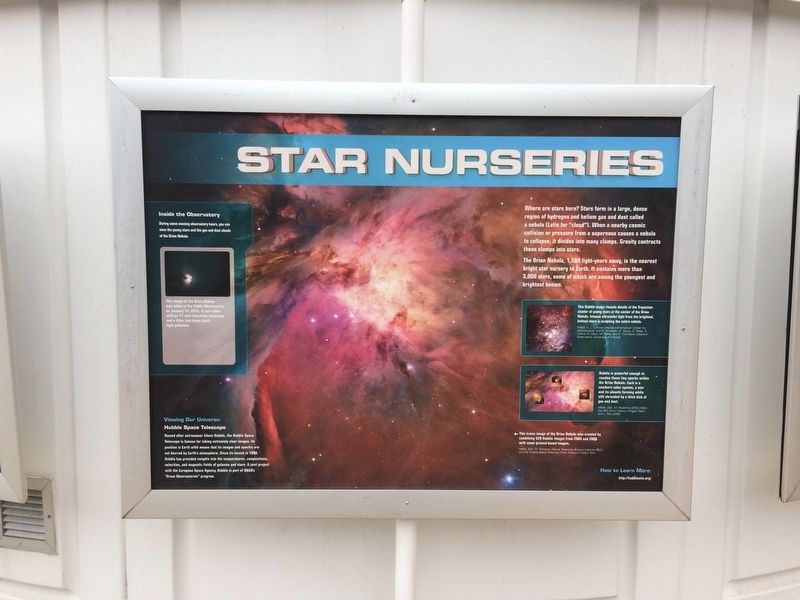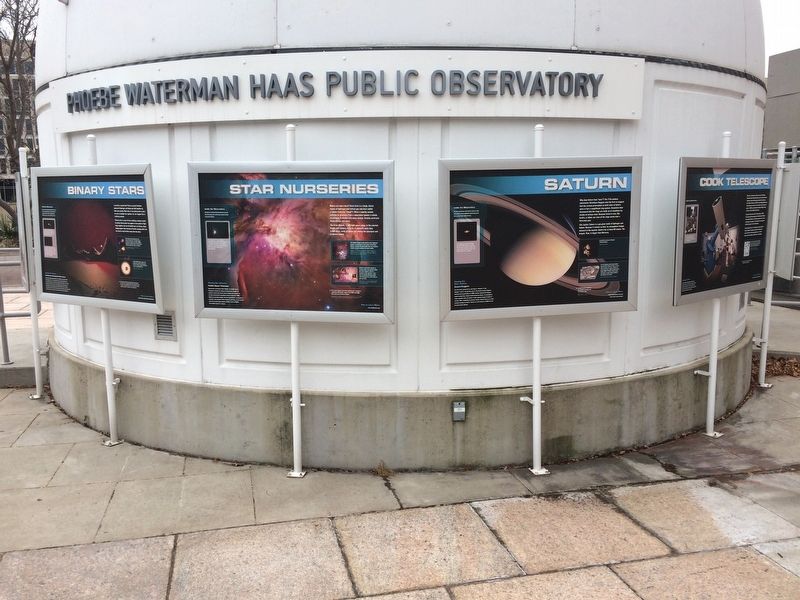The National Mall in Southwest Washington in Washington, District of Columbia — The American Northeast (Mid-Atlantic)
Star Nurseries
Where are stars born? Stars form in a large, dense region of hydrogen and helium gas and dust called a nebula (Latin for "cloud"). When a nearby cosmic collision or pressure from a supernova causes a nebula to collapse it divides into many clumps. Gravity contracts these clumps into stars.
The Orion Nebula, 1,500 light-years away, is the nearest bright star nursery to Earth. It contains more than 3,000 stars, some of which are among the youngest and brightest known.
Captions:
Inside the Observatory
During some evening observatory hours, you can view the young stars and the gas and dust clouds of the Orion Nebula.
This image of the Orion Nebula was taken at the Public Observatory on January 5, 2015. It was taken with an 11-inch Celestron telescope and a filter that helps block light pollution.
Viewing Our Universe:
Hubble Space Telescope
Named after astronomer Edwin Hubble, the Hubble Telescope is famous for taking extremely clear images. Its position in Earth orbit means that its images and spectra are not blurred by Earth's atmosphere. Since its launch in 1990, Hubble has provided insights into the temperatures, compositions, velocities, and magnetic fields of galaxies and stars. A joint project with the European Space Agency, Hubble is part of NASA's "Great Observatories" program.
Hubble is powerful enough to resolve these tiny specks within the Orion Nebula. Each is a newborn solar system, a star and its planets forming while still shrouded by a thick disk of gas and dust.
NASA, ESA, M. Robberto (STScI/ESA), the HST Orion Treasury Project Team, and L. Ricci (ESO).
←This iconid image of the Orion Nebula was created by combining 520 Hubble images from 2004 and 2005 with some ground-based images.
NASA, ESA, M. Robberto (Space Telescope Science Institute/ESA) and the Hubble Space Telescope Orion Treasury Project Team
How to Learn More:
http://hublbesite.org
Erected by National Air and Space Museum.
Topics. This historical marker is listed in this topic list: Air & Space. A significant historical year for this entry is 1990.
Location. 38° 53.276′ N, 77° 1.111′ W. Marker is in Southwest Washington in Washington, District of Columbia. It is in The National Mall. Marker can be reached from Independence Avenue Southwest west of 4th Street Southwest, on the right when traveling west. On the grounds of the National Air and Space Museum on the side of the Phoebe Waterman Haas Public Observatory. Touch for map. Marker is at or near this postal address: 600 Independence Southwest, Washington DC 20024, United States of America. Touch for directions.
Other nearby markers. At least 8 other markers are
Credits. This page was last revised on January 30, 2023. It was originally submitted on December 12, 2017, by Devry Becker Jones of Washington, District of Columbia. This page has been viewed 197 times since then and 13 times this year. Photos: 1, 2. submitted on December 12, 2017, by Devry Becker Jones of Washington, District of Columbia. • Bill Pfingsten was the editor who published this page.

